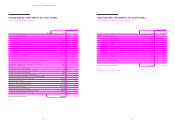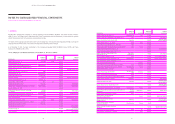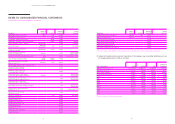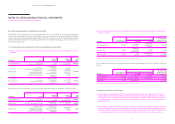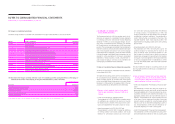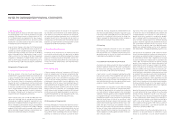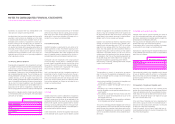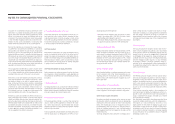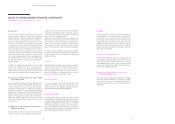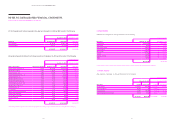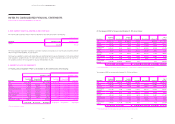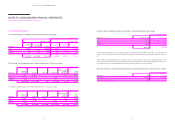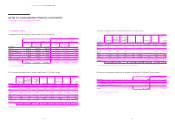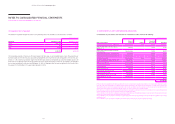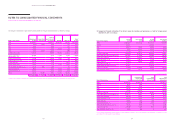Hyundai 2015 Annual Report Download - page 55
Download and view the complete annual report
Please find page 55 of the 2015 Hyundai annual report below. You can navigate through the pages in the report by either clicking on the pages listed below, or by using the keyword search tool below to find specific information within the annual report.
HYUNDAI MOTOR COMPANY Annual Report 2015
108 109
Intangible assets with indefinite useful lives or intangible as-
sets not yet available for use are not amortized but tested for
impairment at least annually.
(16) Non-current assets classified as held for sale
The Group classifies a non-current asset (or disposal group)
as held for sale if its carrying amount will be recovered princi-
pally through a sale transaction rather than through continu-
ing use. For this to be the case, the asset (or disposal group)
must be available for immediate sale in its present condition
subject only to terms that are usual and customary for sales
of such assets (or disposal groups) and its sale must be highly
probable. The management must be committed to a plan to sell
the asset (or disposal group), and the sale should be expected
to qualify for recognition as a completed sale within one year
from the date of classification.
Non-current assets (or disposal group) classified as held for
sale are measured at the lower of their carrying amount and
fair value less costs to sell.
(17) Lease
Leases are classified as finance leases when the terms of the
lease transfer substantially all the risks and rewards of own-
ership to the lessee. All other leases are classified as operat-
ing leases.
1) The Group as lessor
Amounts due from lessees under finance leases are recog-
nized as receivables at the amount of the Group’s net invest-
ment in the leases. Finance lease interest income is allocated
to accounting periods so as to reflect an effective interest
rate on the Group’s net investment outstanding in respect
of the leases. Rental income from operating leases is recog-
nized on a straight-line basis over the term of the relevant
lease. Initial direct costs incurred in negotiating and arranging
an operating lease are added to the carrying amount of the
leased asset and recognized as expense on a straight-line ba-
sis over the lease term.
2) The Group as lessee
Assets held under finance leases are initially recognized as
assets and liabilities of the Group at their fair value at the
inception of the lease or, if lower, at the present value of the
minimum lease payments. Minimum lease payments are ap-
portioned between the finance expenses and the reduction of
the outstanding liability. The finance expenses are allocated
to each period during the lease term so as to produce a con-
stant periodic rate of interest on the remaining balance of the
liability. Contingent rents are recognized as expenses in the
periods in which they are incurred.
Operating lease payments are recognized as expense on a
straight-line basis over the lease term, except where another
systematic basis is more representative of the time pattern in
which economic benefits from the leased asset are consumed.
Contingent rents for operating lease are recognized as ex-
penses in the periods in which they are incurred.
(18) Borrowing costs
Borrowing costs directly attributable to the acquisition, con-
struction or production of qualifying assets are capitalized to
the cost of those assets, until they are ready for their intend-
ed use or sale. A qualifying asset is an asset that necessarily
takes a substantial period of time to get ready for its intended
use or sale. Investment income earned on the temporary in-
vestment of specific borrowings pending their expenditure on
qualifying assets is deducted from the borrowing costs eligible
for capitalization. All other borrowing costs are recognized in
profit or loss in the period in which they are incurred.
(19) Retirement benefit plans
Contributions to defined contribution retirement benefit plans
are recognized as an expense when employees have rendered
service entitling them to the contributions.
The retirement benefit obligation recognized in the consoli-
dated statements of financial position represents the present
value of the defined benefit obligation, less the fair value of
plan assets. Defined benefit obligations are calculated by an
actuary using the Projected Unit Credit Method.
The present value of the defined benefit obligations is mea-
sured by discounting estimated future cash outflows by the
interest rate of high-quality corporate bonds with similar
maturity as the expected post-employment benefit payment
date. In countries where there is no deep market in such
bonds, the market yields at the end of the reporting period on
government bonds are used.
The remeasurements of the net defined benefit liabilities
(assets) comprising actuarial gain or loss from changes in ac-
tuarial assumptions or differences between actuarial assump-
tions and actual results, the effect of the changes to the asset
ceiling and return on plan assets, excluding amounts included
in net interest on the net defined benefit liabilities (assets) are
recognized in other comprehensive income of the consolidat-
ed statements of comprehensive income, which is immediately
recognized as retained earnings. Those recognized in retained
earnings will not be reclassified in profit or loss. Past ser-
vice costs are recognized in profit and loss when the plan
amendment occurs and net interest is calculated by applying
the discount rate determined at the beginning of the annual
reporting period to the net defined benefit liabilities (assets).
Defined benefit costs are composed of service cost (including
current service cost, past service cost, as well as gains and
losses on settlements), net interest expense (income), and
remeasurements.
The retirement benefit obligation recognized in the consol-
idated statement of financial position represents the actual
deficit or surplus in the Group’s defined benefit plans. Any
surplus resulting from this calculation is limited to the present
value of any economic benefits available in the form of re-
funds from the plans or reductions in future contributions to
the plans.
(20) Provisions
A provision is recognized when the Group has a present obli-
gation (legal or constructive) as a result of a past event, it is
probable that an outflow of resources embodying economic
benefits will be required to settle the obligation, and a reliable
estimate can be made of the amount of the obligation. The
amount recognized as a provision is the best estimate of the
consideration required to settle the present obligation at the
end of the reporting period, taking into account the risks and
uncertainties surrounding the obligation. A provision is mea-
sured using the present value of the cash flows estimated to
settle the present obligation. The increase in provision due to
passage of time is recognized as interest expense.
The Group generally provides a warranty to the ultimate con-
sumer for each product sold and accrues warranty expense
at the time of sale based on actual claims history. Also, the
Group accrues probable expenses, which may occur due to
product liability suit, voluntary recall campaign and other ob-
ligations at the end of the reporting period. In addition, the
Group recognizes provisions for the probable losses of unused
loan commitment, construction contracts, pre-contract sale or
service contract due to legal or constructive obligations.
When some or all of the economic benefits required to settle
a provision are expected to be recovered from a third party,
a receivable is recognized as an asset if it is virtually certain
that reimbursement will be received and the amount of the
receivable can be measured reliably.
(21) Taxation
Income tax expense is composed of current and deferred tax.
1) Current tax
The current tax is computed based on the taxable profit for
the current year. The taxable profit differs from the income
before income tax as reported in the consolidated statements
of income because it excludes items of income or expense
that are taxable or deductible in other years and it further ex-
cludes items that are never taxable or deductible. The Group’s
liability for current tax expense is calculated using tax rates
that have been enacted or substantively enacted by the end
of the reporting period.
2) Deferred tax
Deferred tax is recognized on temporary differences between
the carrying amounts of assets and liabilities in the consoli-
dated financial statements and the corresponding tax bases
used in the computation of taxable profit.
Deferred tax liabilities are generally recognized for all taxable
temporary differences. Deferred tax assets shall be generally
NOTES TO CONSOLIDATED FINANCIAL STATEMENTS
AS OF AND FOR THE YEARS ENDED DECEMBER 31, 2015 AND 2014


